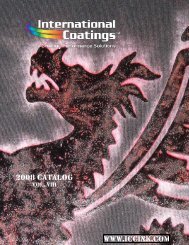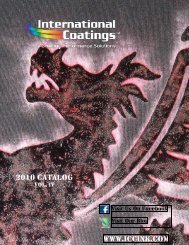2008 CATALOG WWW.ICCINK.COM
2008 CATALOG WWW.ICCINK.COM
2008 CATALOG WWW.ICCINK.COM
You also want an ePaper? Increase the reach of your titles
YUMPU automatically turns print PDFs into web optimized ePapers that Google loves.
INTERNATIONAL COATINGS TRANSFER PRODUCTS<br />
additive, Quick Trans 500, which can be added to our Multipurpose, 700 Series and 1100 Series Plastisols to<br />
convert them to hot split or hot peel transfer inks. The mixed inks will work on non-coated or specially coated<br />
transfer papers. The ratio of ink to additive is 3 to 4 parts ink, to 1 part additive. For light colored fabrics, mixed<br />
Quick Trans 500 inks should be printed through a 110 to 305 monofilament screen mesh. To achieve a more<br />
opaque color, use the 500 additive with HP (High Pigment) colors printed through 60 to 86 monofilament screen<br />
mesh. Screen mesh used should be based on the detail of the design being printed and the type (T-shirt, or<br />
sweatshirt) and color of fabric being transferred to. Use a 60 to 70 durometer squeegee (hardness of squeegee<br />
blade) with a sharp edge. Ink deposit should be about 3 to 4 mils (ink film thickness after gelling) for light colored<br />
fabrics. For dark colored fabrics a 6 to 10 mil film thickness is necessary.<br />
Transfer application time is 4 to 7 seconds with medium pressure, 40lbs on most air operated transfer<br />
machines, at 375°F to 400°F (191°C to 204°C) with either paper. Peel transfer hot. Correctly calibrated transfer<br />
machines are an important part of the transfer process. If transfers do not apply properly, do not forget to check the<br />
transfer machine, as well as the printing and transferring procedures.<br />
OPAQUE HOT PEEL TRANSFERS<br />
Opaque transfers should be printed using International Coatings 500 Series Opaque inks. These inks were<br />
specifically formulated for making very opaque hot peel transfers and will make a better opaque transfer than the<br />
high pigment, 500 additive combination. These inks work best on the specially coated hot peel transfer papers.<br />
They require lower gelation temperatures (180°F to 225°F or 82°C to 107°C) than a standard mixed hot peel<br />
transfer ink. Application time is 3 to 7 seconds with medium pressure, at 375°F to 400°F (191°C to 204°C). For<br />
further information on this product see International Coatings product bulletin 500 Series Opaque Transfer Inks.<br />
PUFF HOT PEEL TRANSFERS<br />
Use International Coatings' 300 Series Puff Transfer Inks to achieve hot peel puff transfers. 300 Series inks<br />
should be printed through a 60 to 110 monofilament screen mesh using a 60 to 75 durometer squeegee with a sharp<br />
or beveled edge. Use non-coated or specially coated hot peel transfer papers. Gelation temperatures are very<br />
important when using this ink. The gelation temperature range is 180°F to 200°F (82°C to 107°C). Over gelation<br />
of this ink may cause the ink to puff on the paper, or to not release properly. International Coatings #303 adhesive<br />
powder must be applied to the ink while it is still wet, to give the ink proper adhesion and durability on the garment.<br />
The powder adhesive is usually applied by dipping the wet transfer in a box of adhesive or by sprinkling. Shake off<br />
the excess adhesive and run through the dryer at the proper temperatures. Brush off excess powder adhesive after<br />
transfer exits dryer, using a soft brush. For multicolor puff transfers, each color of puff must be coated with the<br />
powder adhesive. Application time is 3 to 7 seconds with medium pressure, at 375°F to 400°F (191°C to 204°C).<br />
Peel transfer while hot.<br />
NOTE:<br />
If the transfer does not puff properly, it is usually because of over gelation.<br />
2<br />
121




